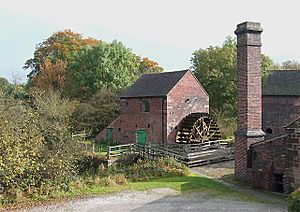Cheddleton Flint Mill facts for kids
Cheddleton Flint Mill is a fascinating old water mill located in the village of Cheddleton, which is in the English county of Staffordshire. A "water mill" uses the power of flowing water to turn large wheels and machinery. At Cheddleton, the water comes from the river Churnet through a special channel called a mill race. People have been using this spot for milling (grinding things) since the Middle Ages, which was a very long time ago! Most of the buildings you see today were built during the time of the Industrial Revolution, but some older parts are still there.
There are actually two mills at this site. One was built in the late 1700s specifically to grind flint. Flint is a very hard rock that was crushed into a fine powder. This powder was then used in the pottery industry to make things like plates, cups, and bowls. The other mill was originally used to grind corn, but it was later changed to also grind flint. The whole mill area includes a house where the miller lived, two special ovens called flint kilns, a drying kiln, and other small buildings. It's also right next to the Caldon Canal, which was an important waterway for transporting goods.
Contents
What is Cheddleton Flint Mill?
Cheddleton Flint Mill is a historic site that shows us how people used to make things during the Industrial Revolution. It's not just one building, but a whole group of structures that worked together.
How the Mill Worked
The main job of these mills was to grind flint. Flint was a key ingredient for the pottery factories in nearby areas like Stoke-on-Trent.
- Water from the River Churnet flowed into the mill race.
- This water turned large waterwheels.
- The waterwheels powered heavy grinding stones inside the mills.
- Flint rocks were put into the mills and crushed into a fine powder.
- This powder was then dried in special kilns.
- Finally, the flint powder was sent to pottery makers to be used in their products.
Protecting This Important History
The Cheddleton Flint Mill complex is very important because it helps us understand how industries worked in the past.
- In 1986, the buildings were given a special "Grade II*" listing. This means they are considered very important historical buildings that need to be protected.
- Today, a group called the Cheddleton Flint Mill Industrial Heritage Trust looks after the site.
- This trust is a registered charity, which means they are a non-profit organization dedicated to preserving this piece of history for everyone to learn from and enjoy. They make sure the mills are maintained and can still operate, showing visitors how things were done long ago.
See Also
- Listed buildings in Cheddleton
- Moddershall
- Etruria Industrial Museum


